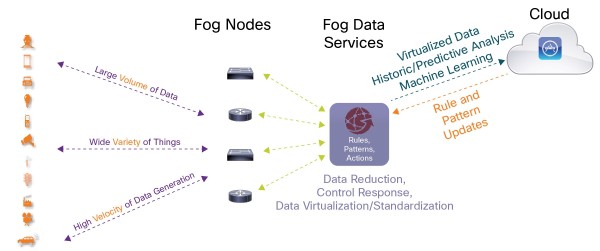
Fog Computing: Extending the Cloud?
In the past ten years, the usage of cloud-based systems to build applications and store data has exploded. As Dr. Jeff Welser of IBM discussed in his presentation on 7 July 2017, the amount of computer power at the edge of the internet exceeds that of all the computers in all the world’s data centers. With fifth generation (5G) wireless trials underway in Tier 1 wireless carriers in several countries, bandwidth will be expanded significantly, and providing connectivity to essentially any device will be possible as long as the device has some type of network interface and an application with which to communicate. Though not discussed last week, my own experience with wireless carriers has been that most focus on performance at the edge of their networks because that is where subscribers interact. While issues involving centralized applications such as E911 can have network-wide impact, most issues related to poor subscriber experience derive from conditions at the edge of the network, e.g., dropped calls, stalled data sessions, and cell site handover during subscriber movement.
As we move into the Internet of Things (IOT), devices and sensors will drive growth in data and requirements for compute power. Many of these devices and sensors will support critical, real-time services that will need assured connectivity, e.g., remote patient monitoring in a healthcare environment or autonomous automobiles (“driverless cars”). Cloud-based environments may have latency that is too long for such applications, and thus extensions to the cloud need to be addressed to enable users to continue to take advantage of cloud functionality while not sacrificing real-time performance.
Enter fog computing, a term coined by Cisco originally.1 Fog computing is defined as, “a horizontal, system-level architecture that distributes computing, storage, control and networking functions closer to the users along a cloud-to-thing continuum.”2 In principle, the idea behind fog computing is to allow intelligence at the edge of the network to deliver fast, short-term analytics closer to where needed, reducing data transmission, storage and compute workload in the cloud. Fog computing represents a resurgence of the philosophy behind the minicomputer systems and architectures of the 1970’s and early 1980’s: distributed systems were used to offload/augment mainframe computers in many industries.
Fog computing is sufficiently evolved in concept that the OpenFog Consortium was formed in November 2015 by ARM, Cisco, Dell, Intel, Microsoft and Princeton University, to lead industry and academia to define a reference architecture and begin driving the creation of standards for interfaces and interaction to ensure that an IoT vision can be realized.1,3 The OpenFog Reference Architecture for Fog Computing is quite detailed. For interested readers, check it out at the following link:
https://www.openfogconsortium.org/wp-content/uploads/OpenFog_Reference_Architecture_2_09_17-FINAL-1.pdf.2
The Reference Architecture is quite detailed in describing use cases in particular, and those cases are heavily focused on sectors targeted by the wireless industry: smart cars, smart cities, and smart buildings, for example. The architecture, similar to the seven-layer International Standards Organization Open Systems Interconnect (ISO/OSI) model used to define commercial network standards back in the day, allows for a flexible, layered approach to deliver assured connectivity using principles such as security, reliability, fault-tolerance, scalability, et al.4
Having previously written about cyber security and smart cars, the sections pertaining to vehicles are particularly interesting. Smart cars equipped with global position system (GPS) sensors, cameras, voice interfaces, real-time video entertainment, etc., will have the ability to generate very large amounts of data in real-time. If 100% of that relied on transmission to the cloud, I doubt that 5G bandwidth would be sufficient to accommodate much vehicular traffic. Smart cars by themselves make a great case for edge-based computing capability, as analytics to support autonomous and enhanced driving need to be locally applied to enable fast decision making and quick action. Smart cars will have to interact with a smart grid in a city to address traffic control, accident avoidance, etc. The grid would reside in a layer about the car, and above the grid could be the cloud or potentially other service layers as applications are designed and built.
Most relevant to connected cars, the OpenFog Reference Architecture contains very specific requirements for security. The expectation is that OpenFog requires cryptographic capability that uses symmetric key ciphers under industry standards (e.g., 128-bit key length minimum AES (Advanced Encryption Standard) and 3DES (Triple Data Encryption Standard), asymmetric key ciphers, hash functions such as SHA-256 (Secure Hash Algorithm 256-bit), approved random number generators, and message authentication code techniques to ensure that inter-system communications and messages are secure, have integrity, are signed, etc. Further, the Reference Architecture has explicit detail about requirements for cryptography in virtualized environments, and it is clear that while allowed, the expectation is that there must be one and only one cryptography controlling virtual machine used by other virtual machines for cryptography service calls. The bottom line to the reader is that employment of these technologies are necessary to ensure that systems in smart cars are trusted and secure.
We have a wild ride ahead of us! But, let’s make sure the “wild” is self-originated, and not resulting from a cyber security issue inherent in the cloud while we ride in our autonomous vehicle.
References
- “Fog Computing: a New IoT Architecture,” Joe McKendrick, Cisco IoT Analytics, RTInsights.com, 2017
- “OpenFog Reference Architecture for Fog Computing,” https://www.openfogconsortium.org/ra/technical-document-download/, Open Fog Consortium, 9 Feb 2017
- “How fog computing pushes IoT intelligence to the edge,” Ben Dickson, TechCrunch.com, 2 Aug 2016
- “Open Systems Interconnection (OSI),” International Standards Organization Standard 35.100, 1994.
Users who have LIKED this post:



